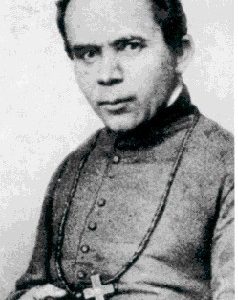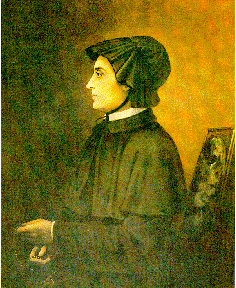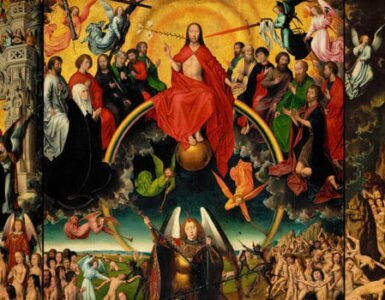Part 32 of This Present Paradise
A Series of Reflections on St. Elizabeth of the Trinity
(Start with part 1 here.)
God has created each one us, every human being, for greater things – to love and to be loved. But why did God make some of us men and others women? Because a woman’s love is one image of the love of God, and a man’s love is another image of God’s love. Both are created to love, but each in a different way. Women and men complete each other, and together show forth God’s love more fully than either can do alone.
That special power of loving that belongs to a woman is seen most clearly when she becomes a mother. Motherhood is the gift of God to women. How grateful we must be to God for this wonderful gift that brings such joy to the whole world, women and men alike! Yet we can destroy this gift of motherhood, especially by the evil of abortion, but also by thinking that other things like jobs or positions are more important than loving, than giving oneself to others. No job, no plans, no possessions, no idea of “freedom” can take the place of love. So anything that destroys God’s gift of motherhood destroys His most precious gift to women — the ability to love as a woman.
So wrote Mother Teresa in a letter to the participants of the 1995 United Nations Conference on Women in Beijing. So simply, so clearly, so powerfully she stated what should perhaps be obvious but what has been obscured in an age of extreme confusion around the dignity of a woman’s unique vocation: that a woman’s motherhood is God’s ‘most precious gift’ to her because through it she loves in a particular way which mirrors His own. It is her superpower, this ‘special power of loving.’ It holds immense creative strength—and it is a great threat to the enemy’s kingdom. Satan cannot create, he can only warp and distort. In his eternal frustration, envy, and rage, he seeks to destroy this incredible God-given gift to the world. He tries to convince women that their maternal nature, rather than something knit into their very being, is taught, something society writes like a fictional narrative, which is nothing more now than evolutionary baggage—and which can be tossed aside or stifled for the sake of other things.
And so God—in anticipation of the lies—raises up icons of Our Lady, of Our Mother, in the bouquet of women saints and says, Here—here is motherhood. Here are women who reflect beautifully this restorative, redemptive kind of love which gives life to the world. And He heals our world through their supreme self-giving and makes the beauty of motherhood palpable, touchable, and able to be imitated in our own lives.
When I first read the letter above as a college student, I remember being struck by the woman behind the words—a woman who had given up natural motherhood for the sake of consecrated virginity, but who became a spiritual mother to thousands dying in the slums of Calcutta, and to all of us who learned from her how to love ‘the least of these.’ Mother Teresa pointed us back to the lost and lonely in our own homes, she urged us to not forget the unborn, she nudged us closer to Jesus and nourished the hesitant longing in our hearts for Him. She was in every real sense of the word a mother. She was completely and authentically a woman, and so really—she could be nothing else.
Virginity according to the Gospel means renouncing marriage and thus physical motherhood. Nevertheless, the renunciation of this kind of motherhood, a renunciation that can involve great sacrifice for a woman, makes possible a different kind of motherhood: motherhood “according to the Spirit” (cf. Rom 8:4). For virginity does not deprive a woman of her prerogatives. Spiritual motherhood takes on many different forms. In the life of consecrated women, for example, who live according to the charism and the rules of the various apostolic Institutes, it can express itself as concern for people, especially the most needy: the sick, the handicapped, the abandoned, orphans, the elderly, children, young people, the imprisoned and, in general, people on the edges of society. In this way a consecrated woman finds her Spouse, different and the same in each and every person, according to his very words: “As you did it to one of the least of these my brethren, you did it to me” (Mt 25:40). Spousal love always involves a special readiness to be poured out for the sake of those who come within one’s range of activity. In marriage this readiness, even though open to all, consists mainly in the love that parents give to their children. In virginity this readiness is open to all people, who are embraced by the love of Christ the Spouse.
Spousal love – with its maternal potential hidden in the heart of the woman as a virginal bride – when joined to Christ, the Redeemer of each and every person, is also predisposed to being open to each and every person. This is confirmed in the religious communities of apostolic life, and in a different way in communities of contemplative life, or the cloister. (Mulieris Dignitatum, 22.)
Elizabeth fully lived her vocation as Bride of Christ. But she also embraced her feminine vocation as a spiritual mother. She did so in her tender concern for her own aching mother, her devotion to her sister, the attention in her letters to the sorrows and joys in those whom God had given her to love. She saw each person with an intuitive sensitivity, right into their souls. She mourned with a friend who had lost her baby daughter and led her gently to Mary: “My heart,” she said, “needs to tell you right away that it is one with yours and asks Him who inflicted the wound to heal it, for only He can do so! I understand so well the grief of your heart, my dear little Marie-Louise, that I won’t try to bring you human consolation; you should take refuge in a Mother’s heart, the heart of the Virgin. It knew all the breaking, all the tearing, and it always stayed so calm, so strong, for it always stayed leaning on the heart of Christ!” (Letter 134)
A woman’s heart, a woman’s soul is created to be like Mary’s — a refuge, a hiding place, a ‘shelter in which other souls may unfold’ in the words of St. Edith Stein. Elizabeth was that safe place to fall and to find hope for everyone who knew her. When another friend mourned her husband, Elizabeth empathetically assured her that “My whole soul, my whole heart are one with yours, for you know Madame, what deep affection unites me to you.” (Letter 195)
When the Carmelite heard that her sister had a little Elizabeth of her own (baby ‘Sabeth’ was born March 11, 1904) she admitted to crying “like a little baby.” (L 196)
“Oh my Guite,” she wrote, “I think I love this little angel as much as her little mama, and that’s saying a lot. And then, you know, I feel completely filled with reverence before this little temple of the Holy Trinity; her soul seems like a crystal that radiates God, and if I were near her, I would kneel down to adore him who dwells within her. My Guite, would you kiss her for her Carmelite aunt, and then take my soul along with yours to recollect yourself close to your little Sabeth. If I were still with you, how I would love to cuddle her, to rock her…goodness knows what else! But the good God has called me to the mountain so I can be her angel and envelop her in prayer, and I very joyfully sacrifice everything else to Him for her sake; and then, there is no distance for my heart, and I am so close to you, you do feel that, don’t you?” (L 197)
From behind the walls of the convent, Elizabeth’s maternal love had been transformed and enriched and taken on a new, deeper power. She pledged to nourish the spiritual life of her niece and her prayers were not without effect—Little Sabeth would eventually enter the same convent as her aunt!
Because she was so attentive to the spiritual growth of her sister, too, teaching Guite about the Trinity dwelling within her soul, she had the holy audacity to claim that when Guite got to heaven, “I will rejoice to see my most beautiful Christ in your soul; I won’t be jealous but with a mother’s pride I will say to Him: It is I poor wretch, who have brought forth this soul to your life.” (L 239) When she became sick, she intuited that from heaven she felt that her maternal role would only grow stronger.
It was really how she saw the Marian-like life of any Carmelite, “as a twofold vocation: ‘virgin-mother.’ Virgin: espoused in faith by Christ; mother: saving souls, increasing the number of the adopted children of the Father, the co-heirs of Jesus Christ.” (L 199) She had an excellent model in her Superior, Mother Germaine, who saw her beloved Elizabeth sensitively through spiritual darkness, relaxed rules when prudent for Elizabeth and her family, and stayed steadfastly by her side during her illness and death. “If you knew what a Mother I have at my side: a true mama, her heart has the tenderness, the delicacy known only to the hearts of mothers,” she confided to a friend. (L 268) When Elizabeth was too sick to receive Communion, for example, Mother Germaine would thoughtfully come to kneel at her bedside after receiving the Eucharist each morning so that Elizabeth could adore the Lord, fully present within her. In her tenderness, she revealed to Elizabeth what every mother reveals: the very Face of God, full of mercy and love.
The Church, a mother herself, invites all of us women to embrace the particular brand of love—the receptive, intuitive, attentive, sensitive, reflective, maternal—especially maternal—love which is her own. To make a supreme gift of herself and to see souls come to life under the umbrella of her feminine heart, regardless of her state in life, her personality, her particular mission, or the brokeness of her past or her current circumstances. To participate in the redemption of the world and the restoration of all things to God under Christ and to do so with a particular spiritual beauty.
And alongside the masculine love of men, to radiate the very love of God in a way, as Mother Teresa said, “more fully than either can do alone.”
Image courtesy of Unsplash.
Editor’s note: This article originally appeared on SpiritualDirection.com and is reprinted here with kind permission.












